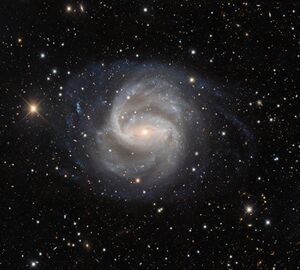Astronomy:NGC 1672
| NGC 1672 | |
|---|---|
 The galaxy photographed with the Víctor M. Blanco Telescope | |
| Observation data (J2000 epoch) | |
| Constellation | Dorado |
| Right ascension | 04h 45m 42.500s[1] |
| Declination | −59° 14′ 49.85″[1] |
| Redshift | 1331 ± 3 km/s[1] |
| Distance | 51.7 ± 3.0 Mly (15.86 ± 0.92 Mpc)[2] |
| Apparent magnitude (V) | 10.3[1] |
| Characteristics | |
| Type | (R')SB(r)bc[1] |
| Apparent size (V) | 6.6′ × 5.5′[1] |
| Other designations | |
| PGC 15941[1] | |
NGC 1672 is a barred spiral galaxy located in the constellation Dorado. It was discovered by the astronomer James Dunlop on November 5, 1826.[3] It was originally unclear whether it was a member of the Dorado Group, with some sources[4] finding it to be a member and other sources[5] rejecting its membership. However, recent tip of the red-giant branch (TRGB) measurements indicate that NGC 1672 is located at the same distance as other members, suggesting it is indeed a member of the Dorado Group.[2]
NGC 1672 has a large bar which is estimated to measure around 20 kpc.[6] It has very strong radio emissions emanating from its nucleus, bar, and the inner portion of the spiral arm region.[6] The nucleus is Seyfert type II and is engulfed by a starburst region.[6] The strongest polarized emissions come from the northeastern region which is upstream from its dust lanes.[6] Magnetic field lines are at large angles with respect to the bar and turn smoothly to the center.[6]
Two supernovae have been observed in NGC 1672: SN 2017gax (type Ib/c, mag. 14.1)[7] and SN 2022aau (type II, mag. 16.3).[8]
General structure
The center of the galaxy contains a high surface brightness bar, and four filament-like spiral arms extend outward from the ends of this bar. The spiral arms are asymmetric; one of the arms in the northeast part of the disk is significantly brighter than its counterpart on the other side. The spiral arms also contain numerous star formation regions, some of which may be as large as ″.[9]
Nucleus
The classification of the nucleus of NGC 1672 is uncertain. Most galaxies may be classified by their spectra as having one of three different types of nuclei:[10]
- A nuclear H II region, a region which has a spectrum similar to that of star formation regions in the Milky Way and which therefore is associated with nuclear star formation activity.
- A Seyfert nucleus, a type of active galactic nucleus (AGN) that may contain a supermassive black hole.
- A low-ionization nuclear emission-line region, a type of nuclear region with spectral line emission from weakly ionized gas that could contain either a star formation region or a supermassive black hole.
NGC 1672, however, is one of several nearby galaxies that does not fit into this classification scheme, as its spectrum appears intermediary between these three classes of objects.[10] It may in fact contain both nuclear star formation regions and an AGN. In some wave bands (such as in ultraviolet light), the star formation regions are the primary source of emission.[11]
Gallery
A Hubble Space Telescope image of the center region of NGC 1672
A GALEX ultraviolet image of NGC 1672
See also
References
- ↑ 1.0 1.1 1.2 1.3 1.4 1.5 1.6 "Results for object NGC 1672 (NGC 1672)". NASA/IPAC Extragalactic Database. California Institute of Technology. https://ned.ipac.caltech.edu/byname?objname=NGC%201672&hconst=67.8&omegam=0.308&omegav=0.692&wmap=4&corr_z=1. Retrieved 2021-04-29.
- ↑ 2.0 2.1 Tikhonov, N. A.; Galazutdinova, O. A. (2020). "Distance to the Dorado Group". Astrophysical Bulletin 75 (4): 384–393. doi:10.1134/S199034132004015X. Bibcode: 2020AstBu..75..384T.
- ↑ Seligman, Courtney. "New General Catalogue objects: NGC 1650 - 1699". http://cseligman.com/text/atlas/ngc16a.htm#1672. Retrieved 2021-04-29.
- ↑ Huchra, J. P.; Geller, M. J. (June 15, 1982). "Groups of galaxies. I - Nearby groups". Astrophysical Journal 257 (Part 1): 423–437. doi:10.1086/160000. Bibcode: 1982ApJ...257..423H.
- ↑ Maia, M. A. G.; da Costa, L. N.; Latham, David W. (April 1989). "A catalog of southern groups of galaxies". Astrophysical Journal Supplement Series 69: 809–829. doi:10.1086/191328. ISSN 0067-0049. Bibcode: 1989ApJS...69..809M.
- ↑ 6.0 6.1 6.2 6.3 6.4 Beck, R.; Shoutenkov, V.; Ehle, M.; Harnett, J. I. et al. (August 2002). "Magnetic fields in barred galaxies. I. The atlas". Astronomy and Astrophysics 391 (1): 83–102. doi:10.1051/0004-6361:20020642. Bibcode: 2002A&A...391...83B.
- ↑ Transient Name Server entry for SN 2017gax. Retrieved 24 March 2023.
- ↑ Transient Name Server entry for SN 2022aau. Retrieved 24 March 2023.
- ↑ A. Sandage; J. Bedke (1994). Carnegie Atlas of Galaxies. Washington, D.C.: Carnegie Institution of Washington. ISBN 978-0-87279-667-6.
- ↑ 10.0 10.1 P. Veron; A. C. Goncalves; M. P. Veron-Cetty (1997). "AGNs with composite spectra". Astronomy and Astrophysics 319: 52–66. Bibcode: 1997A&A...319...52V.
- ↑ "An atlas of ultraviolet spectra of star-forming galaxies". Astrophysical Journal Supplement Series 86: 5–93. 1993. doi:10.1086/191771. Bibcode: 1993ApJS...86....5K.
External links
Coordinates: ![]() 04h 45m 42.500s, −59° 14′ 49.85″
04h 45m 42.500s, −59° 14′ 49.85″
 |



